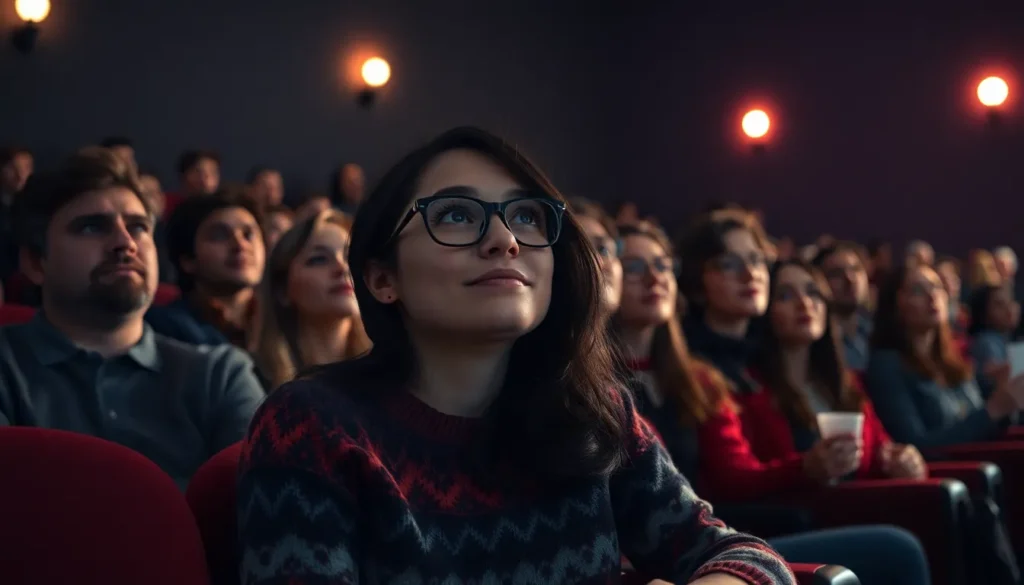Lights, camera, action! Movies have a magical way of capturing our hearts and minds, but have you ever wondered what really lies beneath those iconic scenes? From the heart-stopping plot twists to the tear-jerking moments, every flick has layers waiting to be peeled back. It’s like an onion, but way more entertaining and with fewer tears—unless you’re watching a rom-com!
Table of Contents
ToggleUnderstanding Movie Moments Decoded
Movies often feature iconic scenes that resonate deeply with viewers. Engaging storytelling employs elements such as character arcs, themes, and visual symbolism. Analyzing these components reveals the underlying messages that filmmakers convey. Movies showcase a range of emotional experiences, from joy to heartbreak, with each moment serving a purpose.
Romantic comedies, for example, excel at creating relatable situations that evoke laughter and empathy. Clarity emerges when audiences dissect pivotal moments, revealing the intricate layers of character interactions. Themes of love, friendship, and personal growth often emerge through witty dialogue and clever plot twists.
Cinematography plays a crucial role in shaping the viewer’s experience. Camera angles guide attention, highlighting emotions during critical scenes. Techniques such as close-ups emphasize vulnerability, while wider shots establish context and setting. Emotional responses intensify as audiences connect with characters on screen.
Soundtracks enhance storytelling further, setting the tone and mood. Music cues, often aligned with key moments, evoke specific emotions. Recognizing these auditory signals can deepen understanding of on-screen developments. By decoding these layers, audiences gain insight into the filmmaker’s intentions.
Decoding movie moments encourages active viewing and critical thinking. Engaging with the film’s narrative structure and technical elements enriches the viewing experience. It transforms passive spectators into engaged participants, fostering a deeper appreciation for the art of filmmaking. Through exploration and analysis, viewers can uncover the profound layers that define cinematic storytelling.
Significance of Iconic Scenes


Iconic scenes hold great importance in film, leaving a lasting impact on viewers. They contribute to emotional resonance and narrative depth.
Emotional Impact on Audiences
Iconic scenes often elicit strong emotional responses. They can evoke feelings of joy, sadness, or nostalgia through well-crafted character interactions. Moments like the confession of love in a romantic comedy can prompt viewers to reflect on their own experiences. Memorable lines and gestures enhance these feelings, making scenes relatable. Characters’ journeys become more meaningful, allowing audiences to connect on a personal level. When filmmakers skillfully manipulate timing and delivery, emotions intensify, creating unforgettable cinematic moments. Such scenes often remain etched in memory, shaping how viewers perceive love, loss, and happiness.
Cultural References and Symbolism
Cultural references and symbolism enrich iconic scenes significantly. Filmmakers often incorporate societal elements to create deeper layers of meaning. For instance, a scene depicting a wedding may symbolize unity and commitment. The use of familiar cultural markers invites audiences to engage with the narrative on multiple levels. Iconic imagery, like red roses in romantic contexts, reinforces themes of love and passion. These visual cues resonate widely, creating connections beyond the screen. By embedding cultural references, filmmakers encourage viewers to interpret messages based on their own backgrounds. Such deliberate choices elevate narrative understanding, making iconic scenes more impactful.
Analyzing the Technique
Cinematic storytelling involves layers and techniques that enhance meaning. By examining these techniques, viewers uncover the artistry behind memorable moments.
Cinematic Techniques Used
Cinematography plays a vital role in shaping narratives. Various camera angles and movements set the tone and define emotional depth. Directors utilize close-ups to capture subtle expressions, guiding audience empathy. Lighting is another critical element, often used to create mood or highlight tension. Filmmakers select color palettes to evoke specific feelings, influencing how scenes resonate. Editing techniques also manipulate pace and rhythm, contributing to the overall impact. Juxtaposing shots fosters contrasting emotions, while sound design underpins the visual narrative, creating immersive experiences.
Storytelling through Visuals
Visual storytelling transcends dialogue. Symbolism enriches the narrative, with objects or actions representing broader themes. For example, a couple sharing a meal can symbolize connection or intimacy. Filmmakers employ composition to balance elements within a frame, enhancing visual storytelling. The rule of thirds often guides this arrangement, making scenes visually appealing and drawing focus. Body language communicates unspoken emotions, reinforcing character relationships.
These visual layers invite viewers to engage actively. Understanding these components reveals the filmmaker’s intentions and deepens appreciation for the art form.
Case Studies of Memorable Movie Moments
Memorable movie moments encapsulate the essence of storytelling, revealing the intricacies behind iconic scenes. Each moment serves as a gateway into the emotions and messages conveyed by filmmakers.
Classic Films
Classic films often present unforgettable scenes defined by their visual composition and character portrayals. For example, in Casablanca, the airport scene heightens emotional tension through lighting and camera angles. Emotional complexity emerges, showcasing the characters’ sacrifices and the stakes of love. Another classic, The Godfather, embodies power dynamics in the iconic “I’m gonna make him an offer he can’t refuse” moment. This quote emphasizes character development and moral ambiguity, influencing audiences’ perceptions of loyalty and betrayal.
Contemporary Cinema
Contemporary cinema thrives on blending innovative storytelling techniques with engaging visuals. In La La Land, the opening musical number highlights the vibrant use of color and dynamic choreography, setting the film’s tone and capturing viewers’ attention immediately. Characters’ dreams and struggles resonate, driving home the themes of ambition and love. Similarly, Get Out employs symbolism to unpack societal issues, using unsettling imagery and sharp dialogue. Such elements provoke thought and elicit strong emotional responses, showcasing how new narratives invite audiences to engage with critical themes.
Conclusion
Decoding movie moments reveals the intricate layers woven into cinematic storytelling. By examining iconic scenes viewers can uncover the emotional depth and thematic richness that filmmakers intend to convey. This exploration not only enhances appreciation for the art of film but also encourages a more active engagement with the narratives presented.
As audiences connect with characters and their journeys they may find reflections of their own experiences. The blend of visual storytelling and sound further amplifies these connections creating lasting impressions that resonate long after the credits roll. Embracing this deeper understanding transforms the viewing experience into a journey of discovery and insight.




